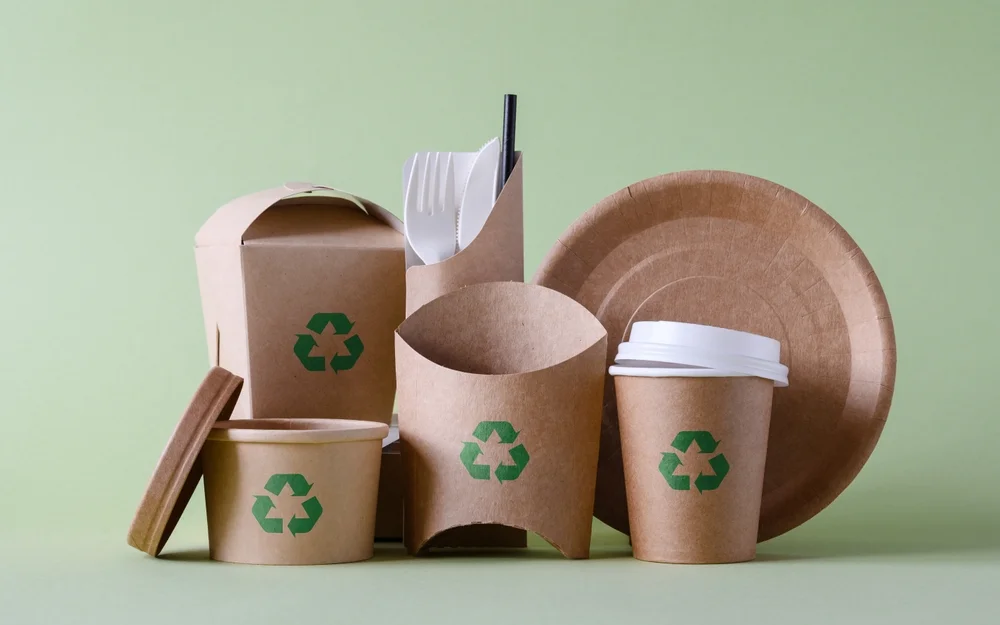A Complete Guide Of Sustainable And Eco-friendly Packaging Materials
Why is Sustainable Packaging Important?
Sustainable packaging materials include biodegradable plastics, recycled paper/cardboard, compostable materials, and plant-based alternatives like cornstarch or mushroom-based packaging.

How do various packaging materials affect the environment?
- Plastic: Regular plastic can take centuries to decompose, contributing to pollution. Bioplastics are more sustainable but might require specific conditions for proper breakdown.
- Paper/Cardboard: Renewable and recyclable, paper packaging is generally eco-friendly. However, excessive production can lead to deforestation.
- Glass: Highly recyclable, but heavy weight increases transportation emissions.
- Metal: Recyclable but energy-intensive during production.
- Biodegradable/Compostable Materials: Generally eco-friendly, but proper disposal conditions are crucial for effective breakdown.
- Plant-Based Plastics: Derived from renewable resources, reducing reliance on fossil fuels, but proper disposal is essential.
Each material has its environmental impact, considering factors like production, transportation, and end-of-life management. Traditional materials like plastic and foam packaging have raised concerns due to their non-biodegradable nature and contribution to pollution.

Exploring Edible Packaging:
Researchers have been experimenting with edible packaging. Imagine packaging that doesn't end up in landfills but can be consumed with the product it encases.
Revolutionizing the Food Industry with Sustainable Packaging: The food industry holds a dual role—preserving the freshness of the product and minimizing environmental impact. However, even traditional materials in this sector are changing.
Finding Packaging Material Near You:
For businesses and individuals looking to make sustainable packaging choices. From local suppliers of recyclable materials to those offering eco-friendly solutions.
Flexible Packaging Materials for Food Products:
Flexible packaging materials for food products include:
- Plastic Films: Lightweight, versatile, and often used for snacks, fresh produce, and more.
- Pouches: Stand-up, resealable, and vacuum pouches offer convenience and protection.
- Foil Pouches: Provide barrier properties against moisture, light, and oxygen.
- Paper-Based Films: Combine paper and plastic for a sustainable yet functional option.
Types of Sustainable Packaging Materials:
Sustainable packaging materials encompass:
- Recycled Content: Packaging from post-consumer recycled materials reduces demand for new resources.
- Biodegradable Plastics: Break down naturally, reducing long-term environmental impact.
- Compostable Materials: Materials that can decompose in industrial composting facilities, leaving behind nutrient-rich compost.
- Plant-Based Plastics: Derived from renewable resources, reducing reliance on fossil fuels.
- Paperboard and Cardboard: Recyclable and often made from sustainable forestry practices.
- Mushroom Packaging: Mycelium-based packaging that's biodegradable and requires less energy to produce.
- Edible Packaging: Made from materials like seaweed, designed to be consumed with the product or biodegrade naturally.
Why are Coatings Important for Sustainable Packaging?
Coatings play a significant role in sustainable packaging due to several key reasons:
- Barrier Protection: Coatings can provide a barrier against moisture, gases, and contaminants, helping extend the shelf life of products and reduce food waste.
- Reduced Material Usage: Effective coatings can enable thinner and lighter packaging materials, reducing the overall environmental impact and resource consumption.
- Enhanced Recyclability: Coatings can improve the recyclability of packaging materials by preventing contamination, making it easier to recycle and reuse.
- Avoiding Laminates: Some coatings can eliminate the need for multi-layer laminates, which can be challenging to separate during recycling.
- Food Safety: Coatings can prevent the migration of substances from packaging to food, ensuring safety and compliance with regulations.
- Printing Quality: High-quality coatings enhance printing and graphics, allowing for attractive and informative packaging designs that engage consumers.
- Minimized Waste: Effective coatings reduce the risk of product spoilage and damage during transportation, minimizing waste along the supply chain.
- Extended Shelf Life: Coatings can protect products from external factors, leading to longer shelf life and reduced need for product replacement.
- Less Energy Consumption: By extending product freshness, coatings can contribute to fewer resources used in producing replacement products and reduced energy for transportation.
- Consumer Appeal: Coatings can enhance the tactile and visual appeal of packaging, making it more attractive to consumers and potentially leading to better sales.

FAQs About Packaging Materials: Striking a Balance Between Sustainability and Functionality
Q: How do packaging materials impact the environment?
Packaging materials have varying environmental impacts. Conventional materials like plastic can contribute to pollution and waste, while eco-friendly options like recyclable materials and bioplastics minimize these effects.
Q: How do various packaging materials contribute to the safety of a package's contents?
Different materials offer varying degrees of protection. Sturdy materials like corrugated cardboard, foam, and bubble wrap cushion items against impacts, moisture, and temperature changes.
Q: Where to buy packaging materials?
Custom Box USA is one of the leading suppliers of packaging materials in the USA. You can buy and print any packaging for your product branding and supplies.
Q: When reusing hazardous materials packaging, what marking must it have?
When reusing hazardous materials, packaging must be marked appropriately with any required hazardous material warnings and labeling to ensure safe handling.
Q: What do you do with packaging materials?
Packaging materials can be reused, recycled, or disposed of responsibly based on their type. Check local recycling guidelines and consider donating or repurposing them if possible.
Q: How do you recycle packaging materials?
Recycling processes vary for different materials. Paper and cardboard can often be recycled curbside, while plastic and metal might require specific drop-off locations.
Q: What are eco-friendly packaging materials?
- Recyclable Packaging
- Compostable Packaging
- Reusable Packaging
- Corrugated Cardboard
- Kraft Folding Carton
- Tin Boxes
- Moulded Pulp
- Cornstarch Packaging
- Collapsible/Magnetic Rigid Boxes
Q: What materials are used in blister packaging?
Blister packaging typically involves a combination of a plastic blister and a cardboard backing, ensuring the product's visibility while providing protection.
Q: What materials are used for packaging?
Common packaging materials include cardboard, paperboard, corrugated board, plastic (PET, HDPE, LDPE), foam, bubble wrap, glass, metal, and more, each tailored to specific packaging needs.

